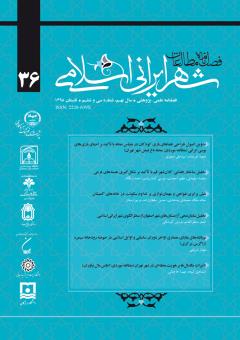تحلیل ساختار فضایی کلان شهر قم با تأکید بر شکلگیری هستههای فرعی
محورهای موضوعی : شهرسازی اسلامیمحمد سلیمانی 1 , موسی کمانرودی 2 , مظهر احمدی 3 , احمد زنگانه 4
1 - دانشیار جغرافیا و برنامه ریزی شهری، دانشگاه خوارزمی، تهران، ایران
2 - استادیار جغرافیا و برنامهریزی شهری، دانشگاه خوارزمی، ایران
3 - دانشجوی دکترای جغرافیا و برنامهریزی شهری، دانشگاه خوارزمی، ایران
4 - استادیار جغرافیا و برنامهریزی شهری، دانشگاه خوارزمی، ایران
کلید واژه: ساختار فضایی, شهرهای چندهستهای, شهرهای تکهستهای, مراکز فرعی شهری, کلانشهر قم,
چکیده مقاله :
از میان الگوهای ساخت شهر، الگوی چندهستهای در مورد شهرهای بزرگ بیشتر صادق است؛ چراکه تجربه نشان داده است شهرهای کوچکتر بهویژه شهرهای تاریخی، اغلب یک هسته شهری دارند که معمولاً در مرکزیت هندسی و محدودۀ تاریخی شهر واقعشده است. این در حالی است که در اثر توسعۀ فیزیکی شهرهای بزرگ به سمت پیرامون، مراکز فرعی شهری شکل میگیرند و بهتدریج ساختار فضایی چندهستهای شهر پدید میآید. مقالۀ حاضر باهدف شناخت تحولات ساختار فضایی کلانشهر قم ازنظر هستهها و مراکز شهری، بهویژه در سه دهۀ اخیر نوشتهشده است. ایده ی اولیه ی تحقیق این بوده است که: «ویژگی ها و کارکردهای مذهبی خاص شهر قم مانع زوال فراگیر بخش مرکزی این شهر در مقایسه با سایر شهرهای و کلانشهرهای کشور شده است.» برای تجزیهوتحلیل دادهها از روشهای کمی شامل تحلیل آماره G عمومی و موران محلی LISA، بیضی انحراف استاندارد و تابع تراکم کرنل در نرمافزار Arc Gis 10.3 استفادهشده است. نتایج این پژوهش نشان میدهد که کلانشهر قم با برخورداری از ویژگیهای مذهبی خاص و قرار داشتن در جایگاه دومین شهر مذهبی کشور پس از مشهد مقدس، همانند بسیاری از شهرهای بزرگ ایرانی – اسلامی رشد شتابان شهرنشینی و گسترش فیزیکی و پراکنده بافت شهری را از اوایل قرن حاضر، بهویژه طی سالهای 1360 تا 1395، تجربه کرده است. در جریان این تحولات، بخش مرکزی شهر قم بسیاری از کارکردهای خود را کماکان حفظ کرده و بهرغم فرسودگی نسبی و موانع و محدودیتهای فیزیکی موجود، در حال حاضر بهعنوان مهمترین هستۀ شهری در ساختار فضایی این کلانشهر مطرح است. در نتیجه، کلانشهر قم در اثر افزایش سریع جمعیت و وسعت (گسترش افقی) و نیز شکلگیری برخی محورها، گرهها و مراکز فرعی در مقیاس شهر، اگرچه در حال دگرگون شدن به سمت یک شهر چندهستهای است؛ اما به دلیل ویژگیهای خاص مذهبی و کارکردهای گستردۀ بخش مرکزی آن، در حال حاضر همچنان بهعنوان یک «شهر تکهستهای» با تسلط هستۀ تاریخی شهر، شناخته میشود.
Among the patterns of building a city, a , polycentric cities pattern of larger cities is true, as experience has shown that smaller cities, especially historic cities, often have a metropolitan core, usually located in the central geometric and historical boundaries of the city. This is due to the physical development of large cities towards the periphery, urban sub-centers, and the city’s multi-core spatial structure gradually emerges. The present paper aims to identify the evolution of the spatial structure of the metropolis of Qom from the viewpoint of the nuclei and urban centers, especially in the last three decades. The idea of this research was that the specific characteristics and functions of the city prevented the city from becoming a part of the city’s central depopulation, as compared to other similar cities. For analyzing data, quantitative methods including general G and LISA statistics, standard deviation and kernel density functions have been used in Arc Gis 10.3 software. The results of the research show that the metropolis of Qom despite its special religious features and its second rank in the religious cities of the country after the holy Mashhad, like many other major Iranian-Islamic cities, have been shown to accelerate urbanization and the physical and diffuse development of urban texture during the year. From 1986 to 2016. During this process, the central part of the city still retains many of its functions, and despite the relative burnout and physical barriers and constraints, it is now considered to be the most important urban core in the metropolis’s spatial structure. Consequently, the metropolis of Qom is rapidly increasing due to the rapid increase in population and extent (horizontal expansion), as well as the formation of some urban centers, nodes and sub-centers, although it is changing to several cities, but because of specific religious features and Its extensive functions in the central part of the city are still known as a Single-core city dominated by the city’s historical core.
